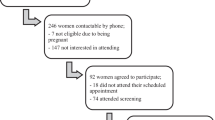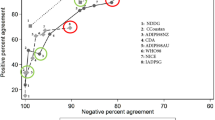Abstract
New diagnostic criteria have recently been proposed that will result in a higher proportion of individuals being diagnosed as suffering from gestational diabetes mellitus (GDM) than previously. The present circum-Mediterranean study sets out to identify the relevance of the new criteria in this population. The study was a prospective, non-interventional, multicentre study in the Mediterranean region. A convenient sample of 1,368 pregnant women was recruited. All participants underwent a 75 g oGTT subdivided into five different glycaemic categories. The women’s anthropomorphic and biological data, together with obstetric and infant outcomes, were collected. There was a threefold increase in diagnosis using the new criteria. Most of the biological characteristics generally associated with GDM showed high specificity and low sensitivity values. The biological characteristics, including maternal age, BMI and FBG, showed a progressive increase as a function of maternal glycaemia with moderate sensitivity and specificity values. Using these latter characteristics in combination ensures that 72.3 % of the GDM population would be correctly identified, while an oGTT would only be required in 18.7 % of the population. The progressive relationship of increasing glycaemia to adverse characteristics suggests that the new IADPSG criteria are reasonable provided that dietary advice is given to all pregnant women. In situations of economic restraints, it appears possible to screen Mediterranean women for GDM risk using a composite model using FBG >5.0 mmol/l combined with the performance of an oGTT in women with a low FBG but who are overweight and aged >30 years.

Similar content being viewed by others
References
Metzger BE, Gabbe SG, Persson B, Buchanan TA, Catalano PA, Damm P, Dyer AR, Leiva A, Hod M, Kitzmiler JL, Lowe LP, McIntyre HD, Oats JJ, Omori Y, Schmidt MI (2010) International association of diabetes and pregnancy study groups recommendations on the diagnosis and classification of hyperglycemia in pregnancy. Diabetes Care 33:676–682
ADA (2006) Diagnosis and classification of diabetes mellitus. Diabetes Care 29(Suppl 1):S43–S48
ADA (2003) Gestational diabetes mellitus. Position statement. Diabetes Care 26(Suppl 1):S103–S105
ADA (2011) Diagnosis and classification of diabetes mellitus. Diabetes Care 34(Suppl 1):S62–S69
IDF (2011) Diabetes atlas. International Diabetes Federation, Belgium. e-version from http://www.idf.org/diabetesatlas
Reyes-Muñoz E, Parra A, Castillo-Mora A, Ortega-González C (2011) Impact of the international association of diabetes and pregnancy study groups diagnostic criteria on the prevalence of gestational diabetes mellitus in urban Mexican women: a cross-sectional study. Endocr Pract 19:1–17
Agarwal MM, Dhatt GS, Shah SM (2010) Gestational diabetes mellitus: simplifying the international association of diabetes and pregnancy diagnostic algorithm using fasting plasma glucose. Diabetes Care 33(9):2018–2020
WHO (1985) Diabetes mellitus. Report of a WHO Study Group. Technical report series 727. WHO, Geneva
Harizopoulou VC, Kritikos A, Papanikolaou Z, Saranti E, Vavilis D, Klonos E, Papadimas I, Dimitrios G, Goulis DG (2010) Maternal physical activity before and during early pregnancy as a risk factor for gestational diabetes mellitus. Acta Diabetol 47(Suppl 1):S83–S89
Shah A, Stotland NE, Cheng YW, Ramos GA, Caughey AB (2011) The association between body mass index and gestational diabetes mellitus varies by race/ethnicity. Am J Perinatol 28(7):515–520
Naylor CD, Sermer M, Chen E, Farine D (1977) Selective screening for gestational diabetes mellitus. N Engl J Med 337:1591–1596
Teh WT, Teede HJ, Paul E, Harrison CL, Wallace EM, Allan C (2011) Risk factors for gestational diabetes mellitus: implications for the application of screening guidelines. Aust N Z J Obstet Gynaecol 51(1):26–30
McCarthy AD, Curciarello R, Castiglione N, Fernández Tayeldín M, Costa D, Arnol V, Prospitti A, Aliano A, Archuby D, Graieb A et al (2010) Universal versus selective screening for the detection, control and prognosis of gestational diabetes mellitus in Argentina. Acta Diabetol 47(2):97–103
López-Tinoco C, Roca M, García-Valero A, Murri M, Tinahones FJ, Segundo C, Bartha JL, Aguilar-Diosdado M (2011) Oxidative stress and antioxidant status in patients with late-onset gestational diabetes mellitus. Acta Diabetol. doi:10.1007/s00592-011-0264:1-8
Acknowledgments
The primary authors of the paper are the guarantors of the study taking full responsibility for the work as a whole, including the study design, access to data, and the decision to submit and publish the manuscript. Charles Savona-Ventura researched data and wrote the manuscript. Josanne Vassallo reviewed and edited the manuscript. Michael Marre reviewed and edited the manuscript. Basil G. Karamanos contributed to discussion. Acknowledgments are due to all the clinical staff in the various centres who in some way assisted with the recruitment of the study population and the performance of the study. Specific acknowledgements are due to Dr. N. Calleja for assisting the statistical analysis. The authors have no conflict of interest to disclose. The study was supported by a financial grant from the Mediterranean Group for the Study of Diabetes who is supported by an unrestricted educational grant from Servier.
Author information
Authors and Affiliations
Consortia
Corresponding author
Additional information
Communicated by Antonio Secchi.
MGSD:GDM Study Group: c/o Faculty of Medicine Xavier BICHAT, University Paris VII, Paris, France.
Appendix
Appendix
The MGSD-GDM study group was composed of key investigators in each collaborating country, including: Algeria (M. Bachaoui, F. Kolli, Z. Benghanem); France (M. Marre); Greece (B. Karamanos, E. Anastasiou); Italy (A. Lapolla, M. G. Dalfrà, A. Filippi); Lebanon (C. Saab); Malta (C. Savona-Ventura, J. Vassallo, J. Craus); Morocco (H. El Ghomari, F. Louda, H. Addi, M. Joubij, A. Chraibi); Portugal (D. Carvalho, S. Belo); Serbia (A. Jotic, N. M. Lalic, A. Ljubic, M. Gojnic, T. Milicic, L. Lukic, J. Seferovic, M. Macesic); Syria (N. Albache, A. Jalek, K. Kebbewaer, M. Albache); and Tunisia (C. Ben Slama).
Rights and permissions
About this article
Cite this article
Savona-Ventura, C., Vassallo, J., Marre, M. et al. Hyperglycaemia in pregnancy in Mediterranean women. Acta Diabetol 49, 473–480 (2012). https://doi.org/10.1007/s00592-012-0427-9
Received:
Accepted:
Published:
Issue Date:
DOI: https://doi.org/10.1007/s00592-012-0427-9




